|
The Battle of Lugalu - 17th August 1891
"Von Zelewski's Last Stand"
|
|
|
|
|
|
|
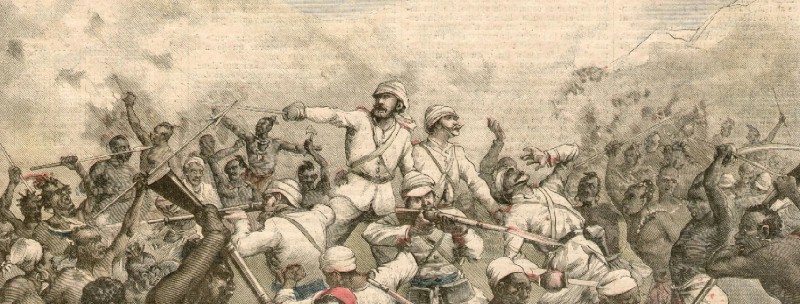
Image from "Le Petit Journal" #45 (October, 3 1891)
Background to Conflict
By 1890 the German armed force known as the Wissmanntruppe had completely defeated Abushiri's Arab Rebellion and thus largely brought peace to the coastal areas
claimed as German East Africa. In May 1891 the Wissmanntruppe were designated
the Kaiserliche Schutztruppe and von Wissmann retired from
African military service
leaving Emil von Zelewski as his successor.
The coastal trading routes were still not completely safe from
attack by local tribesmen however, particularly in the South of the colony where raiders
from warlike tribes such as the Ngoni Mafiti, the Wagogo and the Hehe picked at
trading caravans. The Hehe were in fact expanding their territory from their
base near Iringa towards the
German held coast. They had gone from being a small loosely based tribal
grouping
in the 1850s and expanded by conquest during the reign of Chief
Munyigumbe.
Under his son Chief Mkwawa (who came to throne in 1880), they had united over a
hundred clans and became the
dominant force in the area. In the Summer of 1891 von Zelewski decided to resolve the
situation with military force and organised an expeditionary force at Kilwa to march inland and
confront the tribesmen.
|
|
|
|
|
|
|
|
|
|
|
|
|
|
|
|
| The German Expeditionary
Force |
| |
|
|
|
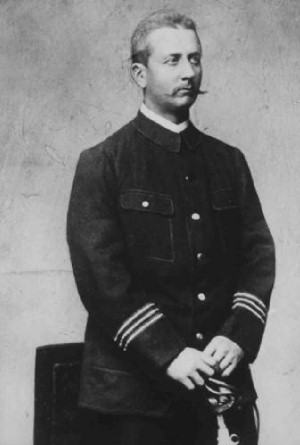
Emil von Zelewski
Photo from Frankfurt University Archive on
Wiki Commons |
|
Commander
Emil von Zelewski was originally commissioned into the 99th Rhineland Infantry Regiment ("2.
Oberrheinisches Infanterie-Regiment Nr.99") before being transferred to the
German East Africa Company in 1886 and the Wissmanntruppe in 1889. He had
successfully lead his own detachments of the Wissmanntruppe both
separately and in conjunction with von Wissmann's columns in many actions during
the Abushiri
Rebellion. He was thus a very experienced commanding officer and was noted as a wise and
cautious leader.The Expeditionary Force
Von Zelewski's force originally consisted of four infantry companies, each of about
90 askaris
commanded by a German officer and NCO. One company was turned back along
the way, probably because of supply problems, leaving three to face the
Hehe. In addition there was an
artillery detachment also commanded by a German officer and NCOs, and
possibly one or two machine guns (see Notes and Discrepancies below).
The expedition took with them many supplies, foraged
from the land and also herded their own cattle.
Condition and Morale of Troops
With the victories against Abushiri's rebels and smaller tribal conflicts behind
them, the German askaris were an experienced force, well trained by African
standards and with high morale.
Up until this point the
Germans had never come up against any serious resistance from inland tribes and
a certain amount of over-confidence was probably in effect amongst their
officers.
|
| |
|
|
|
ORGANISATION OF VON ZELEWSKI'S EXPEDITION 17th
AUGUST 1891
|
|
Unit |
German Officers |
German NCOs |
African Personnel |
| |
| Command |
Commandeur von Zelewski (†) |
|
|
| |
| Askari
Infantry Companies |
| |
5. Compagnie |
Lieutenant von Zitzewitz (†) |
Unteroffizier von Tiedewitz
(†) |
Sudanese Askaris |
| 6. Compagnie |
Lieutenant von Tettenborn |
Feldwebel Kay |
Sudanese Askaris |
| 7. Compagnie |
Lieutenant von Pirch (†) |
Unteroffizier Schmidt (†)
Büchsenmacher Hengelhaup (†) |
Zulu Askaris |
| |
| Artillery
Detachment |
| |
3x c73 Field Guns
or
1x c73 Field Gun and
2x Machine Guns
(see
Discrepancies below) |
Lieutenant von Heydebreck |
Unteroffizier Thiedemann (†)
Unteroffizier Herrich (†)
Unteroffizier Wutzer |
Askari Gunners |
| |
|
Medical
Section |
| |
Arzt Dr. Buschow (†) |
Lazarethgehülfe Hemprich (†) |
No mention has yet
been found of Askari medics, stretcher bearers or assistants, yet it
seems reasonable to assume some were detached for these duties. |
| |
|
Supply Column |
| |
170 African Porters
27 Donkeys (total including those ridden by officers, pack animals and
those pulling the artillery)
20 Cows
60 Sheep and Goats |
| |
| Total |
6 German Officers |
8 German NCOs |
3 Effendi (Askari Officers)
-Murgan Effendi
-Gaber Effendi
-One unknown (†)
318 Askari NCOs and Other Ranks
170 Porters |
Uniforms, Equipment and
Weapons
German Schutztruppe Officers
and NCOs Uniforms
The German officers and NCOs would have been wearing their
khaki active service uniforms and white tropical helmets with khaki covers. New
uniforms had been approved by the Colonial Office in Berlin for the East African
Schutztruppe in June 1891. I think it doubtful however that the new uniforms had
reached Kilwa by July 1891, when the expedition set off. Von Zelewski and his
German officers and NCOs would therefore probably have still been wearing the
old uniforms of the Wissmanntruppe (with their yellow metallic lace rank bars on
the cuffs for officers). NCOs rank was displayed with yellow metallic lace chevrons on the upper left
arm. Equipment would usually have been in the form of Sam Brown style
belts in brown leather for officers and senior NCOs, with junior NCOs carrying
an 1887 ammunition pouch one either side of the belt. Their backpacks, tents and
personal possessions would mostly have been carried by porters but they would
most likely have carried their own essentials such as water bottles and
binoculars.
Recommended Internal Link - Wissmanntruppe German Officers and NCOs
Uniforms
Effendi Uniforms
Three African officers ("Effendi") were part of the
expeditionary force. The Effendi wore the tarbush of the askari other ranks but
with the khaki uniform of their German counterparts. Their rank was shown by one
to three five pointed metal stars on the shoulder straps.
Recommended Internal Link -
Effendi
Uniforms
Askari Uniforms
I have so far found no photographs of the Zelewski Expedition but other
photographs of the period indicate the style of the askari uniforms at this
time. By 1891 all askaris would be wearing the khaki uniforms of the style
originally used by the Sudanese in the Anglo-Egyptian army and adopted from them
by the Wissmanntruppe and Schutztruppe. NCO rank insignia was worn in the form
of red chevrons on the upper (or sometimes lower) left arm. Sudanese askaris
usually wore the khaki tarbush with neckshade, and the Zulu askaris may have
done the same or possibly still be wearing their red fezzes for active service.
It seems from period photographs that neither company numbers nor imperial
eagles as seen on later askari tarbushes were used at this stage. Puttees were
worn in dark blue/grey with brown leather short boots. Equipment was also in
brown leather with an 1887 ammunition pouch either side of a plain brass belt
buckle. At the Battle of Lugalu the askaris presumably had little time to discard their full marching
order (water bottle, bread bag, backpack and tent section- wrapped around the
backpack or over the shoulder) before finding themselves in hand to hand combat.
Recommended Internal Link - Schutztruppe Askari Uniforms c1891
African Auxiliaries Appearance
The few African scouts that von Zelewski did deploy slightly ahead of the column
would probably be warriors from neighbouring tribes, barely dressed not
dissimilarly to the Hehe themselves. The 170 porters, herdsmen and servants of
the Schutztruppe did not wear uniforms. Period photographs usually show them
simply dressed with a loincloth or blanket wrapped around their bodies. They
were often bareheaded and barefooted.
Recommended Internal Link - African Auxiliaries in
East Africa
Weapons
The askaris were armed with the single shot Mauser Jägerbüchse 71 rifle and
probably the S71 long bayonet. German junior NCOs would have been likewise
armed. Officers and senior NCOs were armed with pistols, mostly likely the 1879
Revolver. Some may have carried privately purchased weapons. Swords were also
carried by officers and NCOs, although were not always carried on active
service. The Effendi were armed the same as German officers. African scouts may have carried their own weapons, including
spears and possibly out-dated firearms. Porters were not armed.
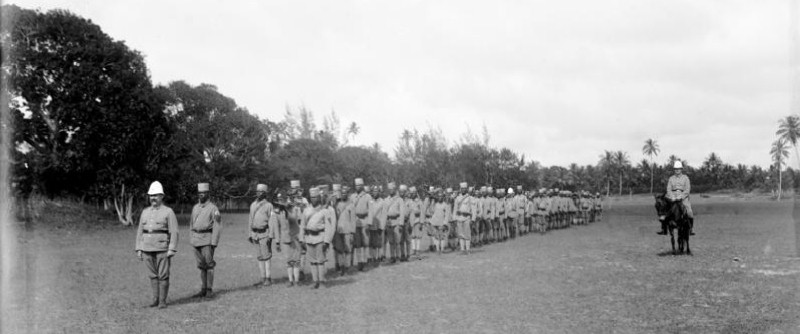
A Schutztruppe Field Company on the March in the early 20th
Century. Note the officer on a donkey on the far right
Photo by Walther Dobbertin from Frankfurt University
Archive on
Wiki Commons
Preparation for War
The expedition left Kilwa on 22nd July 1891 and travelled through Mafiti
territory to Kisaki and onto Myombo (near Kilossa), reaching the Lugalu region
by 16th August. So far, despite burning down several villages, they had met no
resistance. They had often seen numbers of armed Wahehe en route, but these had
always retreated as soon as shots were fired at them. This it seems, led von
Zelewski into believing that his show of force would deter any conflict and
force the Hehe into surrender.
|
|
|
|
|
|
|
|
|
|
|
|
|
|
|
|
The Hehe Army |
|
|
|
|
|
|
|
Commander
Mpangire was the brother and second-in-command of the Hehe chief Mkwawa. He
commanded the Hehe army at Lugalo. Like most of the Hehe army he
had combat experience although only against rival tribes rather than a European
organised army. Unlike many African tribes who were led into battle by their
chiefs, the Hehe followed the European tactic of leaving their commander in
the rear to direct actions.
Forces and Strength
The Hehe army at Lugalo consisted of around 3,000 warriors. Nigmann described the
Hehe as
possessing "an art of war developed to a level far superior to that of the
other native peoples". They had indeed mastered battlefield tactics and
their armies fought as regiments under clear structural commands following
prepared plans as opposed to many African tribes who relied on solely on
guerrilla strikes and disorganised charges.
Condition and Morale of Troops
Their previous victories over
neighbouring tribes had given them combat experience and probably a sense of
superiority in the area. Like many tribal armies their loyalty and bravery in
battle was unquestionable. They were fighting to protect their homeland from a
foreign invader.
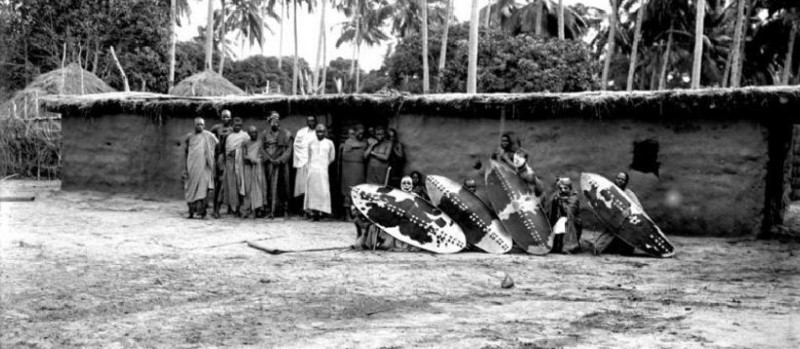
Hehe Warriors in the early 20th Century. Note the hide shields and facepaint or
masks of the warriors in the foreground.
Photo by Walther Dobbertin from Frankfurt University
Archive on
Wiki Commons
Uniforms/Appearance
I have found very few period photographs or illustrations of Hehe warriors.
According to contemporary accounts the Hehe warriors were sparsely dressed. Some
were naked others wore hide belts from which hide strips or animal pelts hung to
cover their genitalia. A few wore long cloths wrapped around themselves, though
these may have been discarded in battle. Such clothing became more common in the
late 1890s. Wristbands and necklaces of beads have also been described. They
sometimes wore headdresses consisting of feathers, coloured pom-poms or
decorations of animal furs. The photograph above shows some of them with either
white painted faces or masks.
Weapons
Hehe warriors were armed with almost mostly with spears (carrying up to six for throwing and
a short spear with a long blade for stabbing). They carried long oval hide
shields of the style made famous by the Zulu, with at least some regiments distinguished by their shield pattern (one
elite regiment had only white hide shields). Some Hehe were also known to have
carried short swords and axes around this period (see photos of a Hehe axe at
RR Traders). They had limited
numbers of muskets from the 1870s onwards but firearms were apparently not used to
any decisive effect in the Battle at Lugalu.
Preparation for War
Chief Mkwawa was well aware of the German troops coming his way. Reports had
reached him early on of their formation and intentions. Scouting groups of his
warriors then observed the force as they approached Uhehe
territory reporting back on the column's movements and strength. An ambush was
prepared for the German force near Lugalu.
|
|
|
|
|
|
|
|
|
|
|
|
|
|
|
|
The Battle of Lugalu |
|
|
|
|
|
|
|
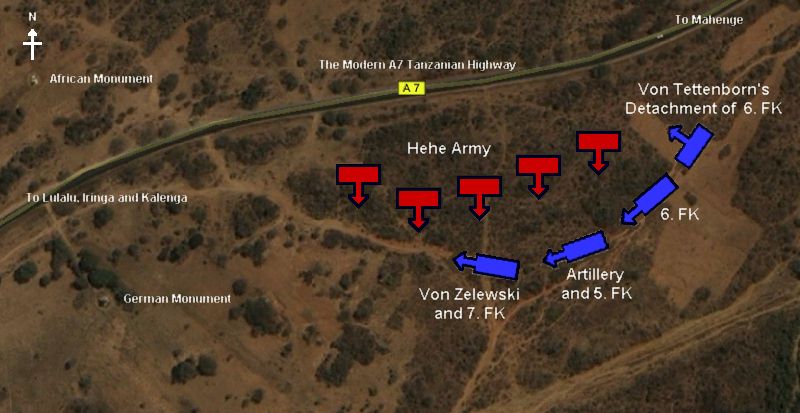
The Battle of Lugalu 0700 HRS 17th August 1891
Original Image from
Google Earth
The Battlefield
The battlefield is near the village of Lugalu, about 10 miles East of Iringa. It
is just off the route of the modern A7 Tanzam Highway. There was a large ridge
to the right of the intended route of von Zelewski's force, behind which the Hehe
lay in wait. The ground sloped downwards further to their right. The terrain was
covered in dry grass with thickets of dense bush and large rocks strewn about.
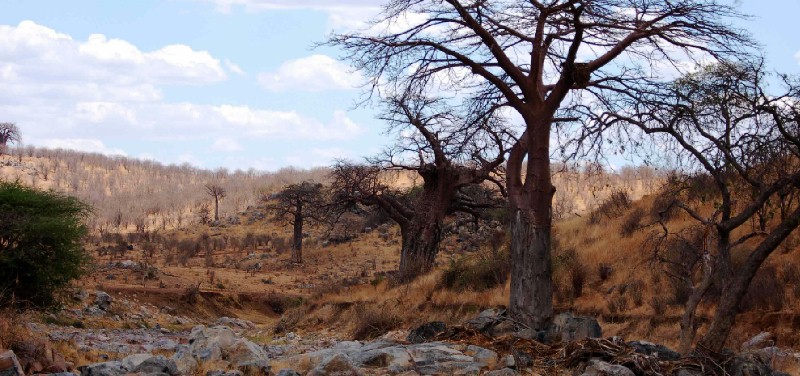
The dry Ruaha Riverbed not far from the battlefield, giving an idea of the
terrain of the area.
Photo by Paul Shaffner on
Wiki Commons
Timescale of Events during the Battle
August 17th 0600 HRS
The expedition started off from just outside of Lugalu marching
towards Kalenga. Despite being an experienced and reputedly cautious commander
von Zelewski made the mistake of not sending scouts far up ahead and more
particularly to his flanks to secure the route of the main force. They marched,
often in single file through the bush
in the following order-
-African Scouts with 10 Zulu Askaris of the 7.
Compagnie
-Commandeur von Zelewski and Arzt Dr. Buschow
-Lieutenant von Pirch with the bulk of the 7. Compagnie including Unteroffizier Schmidt
and Büchsenmacher
Hengelhaupt
-Artillery Detachment including Unteroffiziere Thiedemann,
Herrich and Wutzer, then Lieutenant von Heydebreck
-Lieutenant von Zitzewitz with the 5. Compagnie including Unteroffizier
von Tiedewitz, Lazarethgehülfe Hemprich
-Feldwebel Kay with 40 Sudanese Askaris of the 6. Compagnie
-Porters and Luggage
-Lieutenant von Tettenborn with another 20
Sudanese Askaris of the 6. Compagnie
-Cattle, Sheep and Goats
-The remaining 12 Sudanese Askaris of the 6. Compagnie
Meanwhile the Hehe had prepared an ambush at Lugalu.
The warriors remained
hidden from view behind a ridge to the left of the column's
route. A Hehe lookout post was to fire a single musket shot as a signal
to attack when the German column was in the ideal ambush position.
August 17th 0700 HRS
As the expeditionary force started its march below the ridge a German
officer spotted a flock of birds and fired a shot at them hoping
to bag some early morning hunting. This was mistaken by the Hehe army as the signal
to attack while the column had not quite reached the arranged ambush position.
Thousands of Hehe stormed over the ridge top and onto the German column below,
screaming the war cry for which they had been named "Hee
Twahumite! He heeeeee!".
Many, if not all of the askaris marched with unloaded rifles
and barely had time to load let alone form up defensive squares
before the Hehe were upon them. The design of the newly issued 1887 cartridge
pouches was not familiar to the askaris and vital seconds were lost before they
could open fire, even then only one or two volleys were fired. There was no time to put the
artillery into action. Chaos ensued, pack animals and porters fled. The artillery donkeys
stampeded into the askaris of the 5. Compagnie. Many askaris
also ran for their lives.
August 17th 0715 HRS
The Hehe took as little as fifteen minutes to
over-run the German column. Von Zelewski was killed on his donkey when he turned to one side to
fire on one group of Hehe warriors only to be stabbed with a spear from the
other side. Lieutenant von Pirch and Dr. Buschow were similarly cut down from
their donkeys with fatal stab wounds. Most of the 7. Compagnie, Artillery
Detachment, 5. Compagnie and
advance party of the 6. Compagnie were slaughtered where they stood.
Lieutenant von Heydebreck,
Unteroffizier Wutzer and Murgan Effendi with about 20
askaris managed to break away from the action and work their way up the slope to make a base there
defending themselves against further Hehe attacks.
Only Lieutenant von Tettenborn's rear guard did not bear the
full force of the Wahehe attack, probably saved only by the premature
mistaken signal for action. Von Tettenborn, Feldwebel Kay and about 20 Sudanese
askaris moved to the left of the main fighting and took up a
circular defensive position further up the ridge, with unarmed porters and
wounded in the centre. From here they flew a German flag from a tree and sounded
the bugle call to rally any survivors and stragglers.
The Hehe by this point were chasing routed survivors and looting the expedition's
supply column. Confusion was further spread by their setting fire to the dry
grass.
August 17th 0830 HRS
Lieutenant von Heydebreck,
Unteroffizier Wutzer and Murgan Effendi with about 12 askaris broke out of their
position and joined up with von Tettenborn's defensive circle. Von Heydebreck
was bleeding badly from two spear wounds behind his right ear. From these men
von Tettenborn learned that the majority of the column had been destroyed and
the artillery captured.
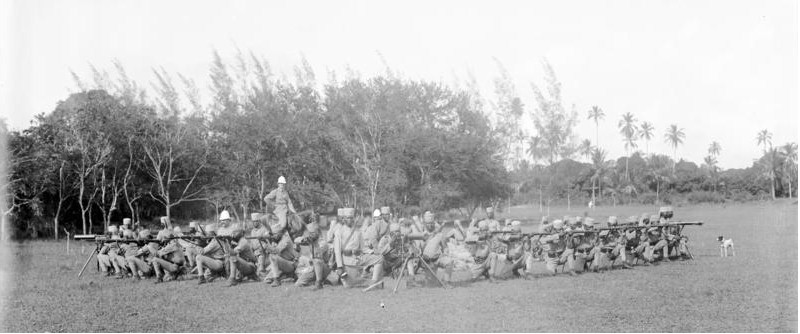
Schutztruppe Askaris formed into a defensive square during
training in the early 20th Century.
Photo by Walther Dobbertin from Frankfurt University Archive on
Wiki Commons
August 17th 0900 HRS
Unteroffizier Thiedemann, with severe
spear and burn wounds was brought into Lieutenant von Tettenborn's camp by a
patrol of askaris. The burning grass was now threatening von Tettenborn and
his survivors' position.
August 17th 1600 HRS
By now Lieutenant von Tettenborn
had gathered as many survivors and wounded as possible and recovered some of the
column's luggage. The still menacing Hehe along with the grass fires made it
impossible to search for more survivors and many of the wounded probably
burned to death. Von Tettenborn decided to begin the retreat before he was cut
off from doing so by the Hehe.
August 17th Nightfall
Lieutenant von Tettenborn's
group camped that night next to a river some way past their previous night's
encampment. His group now consisted only of himself and Lieutenant von Heydebreck,
3 German NCOs (although Unteroffizier Thiedemann died of his wounds later on the
journey), 2 Askari Officers, 62 Askari NCOs and other ranks, 74 porters and 7
donkeys. From there they marched back, mostly by night to avoid further
Hehe attacks, and reached Myombo on August 29th.
|
|
|
|
|
|
|
|
|
|
|
|
|
|
|
|
Casualties and Conclusions
For the Germans who had lost their commander and a quarter of
the colony's armed force in one day it was a devastating blow. It was another three years before another German expedition
under Oberst
Freiherr von Schelle was able to decisively beat the Hehe at Kalenga in 1894.
A
memorial obelisk was later built to von Zelewski's expedition near the site of
the 1891 battle, it is on the South side of the modern Tanzam A7 road on the
approach to Lugalu from the direction of Mahenge. Another memorial was later built to the
victorious Hehe who died in the Battle of Lugalu. It is on the North
side of the A7 road.
| German Casualties |
German
Officers |
German
NCOs |
Askari
Officers |
Askari
NCOs and Other Ranks |
African
Porters |
| |
| Full Strength |
6 |
8 |
3 |
318 |
170 |
| |
| Killed or Missing |
4 |
6 |
1 |
256 |
96 |
| |
| Survivors |
2 |
2 |
2 |
62 |
74 |
| Wounded
among the survivors |
1 |
- |
- |
11 |
7 |
There are no accurate figures as to the losses of the Hehe
army. Estimates vary from as few as 260 to as many as 1,000 (see
Notes and
Discrepancies below). They had however
won a complete victory, one of those rare moments in colonial history such as
Isandlwana or Little Big Horn where a tribal army
inflicted a complete defeat over a better armed colonial one. It was indeed the
biggest defeat and single day's loss in German colonial history.
The Hehe army was not in a position to follow up its victory with
further strikes at large German forces though. Instead, they continued to harass trading
caravans and fight small actions against the Schutztruppe for the next three years until
defeated at their fortified capital at Kalenga in 1894. The rebellion was largely
finished there. Mkwawa and a small band of followers continued guerrilla
resistance until his final entrapment and suicide in 1898.
|
The Wahehe remained loyal to German rule
from then on even during the Maji-Maji rebellion, when they
offered their warriors to fight alongside the Schutztruppe. During the First
World War when British and South African troops eventually pushed the
Schutztruppe towards Iringa the warriors of the Wahehe finally turned on
the Germans again.
In a bizarre and gruesome twist to the tale, the
Schutztruppe had removed Chief Mkwawa's head after his suicide and taken it as
proof of his death. The skull was later taken back to Germany.
As repayment for the assistance in the First World War, the
British demanded Mkwawa's skull back on behalf of the Wahehe in the Treaty of
Versailles (Article 246). It was eventually belatedly returned by the West German
government in 1954.
It is now in the Mkwawa Memorial Museum in Kalenga,
Tanzania.
|
|
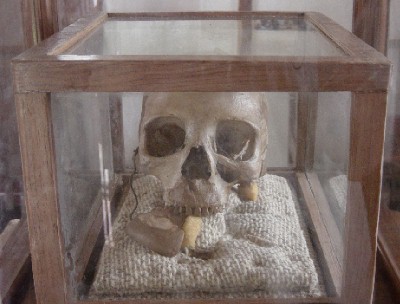
The Skull of Chief Mkwawa
Photo by Matt Crypto at the Mkwawa Memorial Museum,
Kalenga on
Wiki Commons |
| |
|
|
|
|
|
|
|
|
|
|
|
|
|
|
|
|
|
|
Notes and Discrepancies
The books and websites I have used as source material for this article do not
always agree on many details of the battle and the forces involved. This is not
surprising as probably less than ten literate eyewitnesses survived the day. For
the most part I have gone with von Tettenborn and Nigmann's figures, especially for the German side
of events. Maximilian von Tettenborn was of only two surviving German officers
and eyewitnesses to the battle. Ernst Nigmann was a serving Schutztruppe officer
with personal experience of the Wahehe, who less than twenty
years after the battle was commissioned to write a full and detailed official
history of the East African Schutztruppe. For his sources he had full access to
original documentation, including von Tettenborn's account and also was able to interview other serving officers and
veterans. That is not to say he is always correct. Where sources have disagreed
on major issues, I have noted them below.
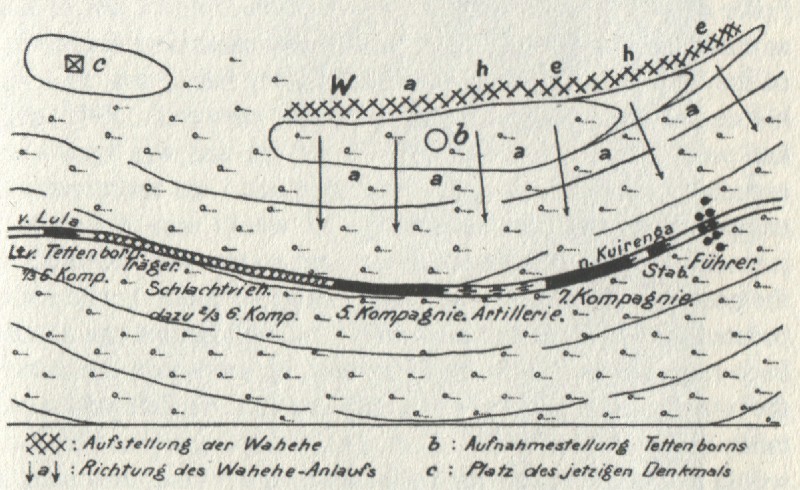
Nigmann's Map of the Battlefield
Illustration from "Geschichte der kaiserlichen
Schutztruppe fur Deutsche-Ostafrika"
This is the map that originally
appeared in Ernst Nigmann's 1912 book "Geschichte der kaiserlichen
Schutztruppe fur Deutsche-Ostafrika". Note that the Memorial (marked "C") and the
hill with the Hehe army waiting in ambush are in similar positions to the Google
Earth photograph above. What is very different is that Nigmann has von
Zelewski's column being attacked from their left while marching to the East,
away from Karenga (although he marks it as towards Kuirenga). This must be
a simple cartographical mistake, all accounts (German and African) agree that he
was marching towards Mkwawa's stronghold when he was ambushed. In which case he
would have been marching West and if the location is correct, attacked from the
right. Tettenborn does not specify from which side the attack began.
The Opening Shot
Nigmann says that the unnamed German who
inadvertently sprung the ambush was firing at an eagle. Mkwawa.com says it was at a flock of
Guinea fowl. Both types of birds can be found in East Africa.
Tettenborn says it was a signal shot but does not mention who fired it or if it
was at any birds at all.
Strength of the German Force
I have quoted Nigmann for the organisation and
strength of the German expeditionary force, although within his own text there
is some ambiguity and it is possible he made a mistake. Nigmann says the force
consisted of 362 askaris, whereas most other sources describe about 320 askaris.
Nigmann's total askari casualties and survivors do not then add up. When
totalling the dead, wounded, missing and surviving askaris in Nigmann's book it
seems the original number would have to have been 318. Nigmann and von
Tettenborn agree on the organisation of the force with three companies of
askaris. Peers is alone in asserting that there were five.
Organisation of the German Force
I have seen no clear table listing the organisation and deployment of officers
in the German force. I have compiled the organisational table above from
comparing Nigmann and von Tettenborn's accounts and inferring which officers
commanded which units from where they were in the order of march. Both accounts
agree that the column marched with the 7. Compagnie first, followed by the 5.
and 6.. Nigmann says one company was made up of Zulu Askaris, two of Sudanese
but does not say which. Von Tettenborn says the Zulus were at the front (so
presumably would have been the 7. Compagnie) leaving the 5. and 6. which would
have to be Sudanese.
German Artillery and Machine Guns
Nigmann initially says the expedition had one artillery
piece and two machine guns. Later he says they had three guns, perhaps counting the artillery and
machine guns together. Von Tettenborn does not mention any machine guns but
refers to three artillery pieces ("Geschütze")
being captured by the Hehe. Peers
relates that the Germans did manage to get one of their machine guns into
action, though this is not corroborated by von Tettenhorn.
Strength of the Hehe Army
Nigmann estimates the Hehe strength at between
3,000 and 5,000, most other sources including von Tettenborn, Beck and Peers, stick to the lower end of that scale at
around 3,000.
Hehe casualties
Mkwawa.com says up to a thousand Hehe were killed in the battle, Peers and Beck
figure it as low as 260. Von Tettenborn estimated the number at 700 including several
chiefs. He mistakenly included Chief Mkwawa among those reported dead.
Leaving the Battlefield
Nigmann reports that von Tettenborn as his band of survivors remained on the
battle field searching for survivors until the next day, August 18th. Peers says
he stayed two days. Von Tettenborn own account says that he left about 1600HRS
on the day of the battle as he feared the Hehe would cut off his chances of
retreat if he stayed any longer.
"Hehe", "Wahehe" and "Uhehe"
The word Wahehe is often used in the same context
as Hehe. Hehe is the name of the people and their Bantu language. It was
allegedly based on their war cry of "Hee Twahumite, Hee Twahumite! He, he, he, heeeeee" (or "Hey, we have come out! Hey, hey,
hey, hey!")" and was used by their
enemies (including the Germans) to describe them. The Hehe then adopted the name
from their neighbours. Strictly speaking Wahehe, with the prefix "Wa-", is the group
collective term. With the prefix "U-", as in Uhehe it describes their
land. All personal names are prefixed by "M-" as in Mkwawa and Mpangire in Hehe Bantu.
English and German Spellings of African Place
Names
Various spellings are used in different
sources. Local African place names have been spelled in various ways over the
years by German and later British officials. Most commonly Lugalu or Lugalo is
spelled Rugaro in German, and Kalenga called Kuirenga.
|
|
|
|
|
|
|
|
|
|
|
|
|
|
|
|
The Destruction of a German Expedition in Africa
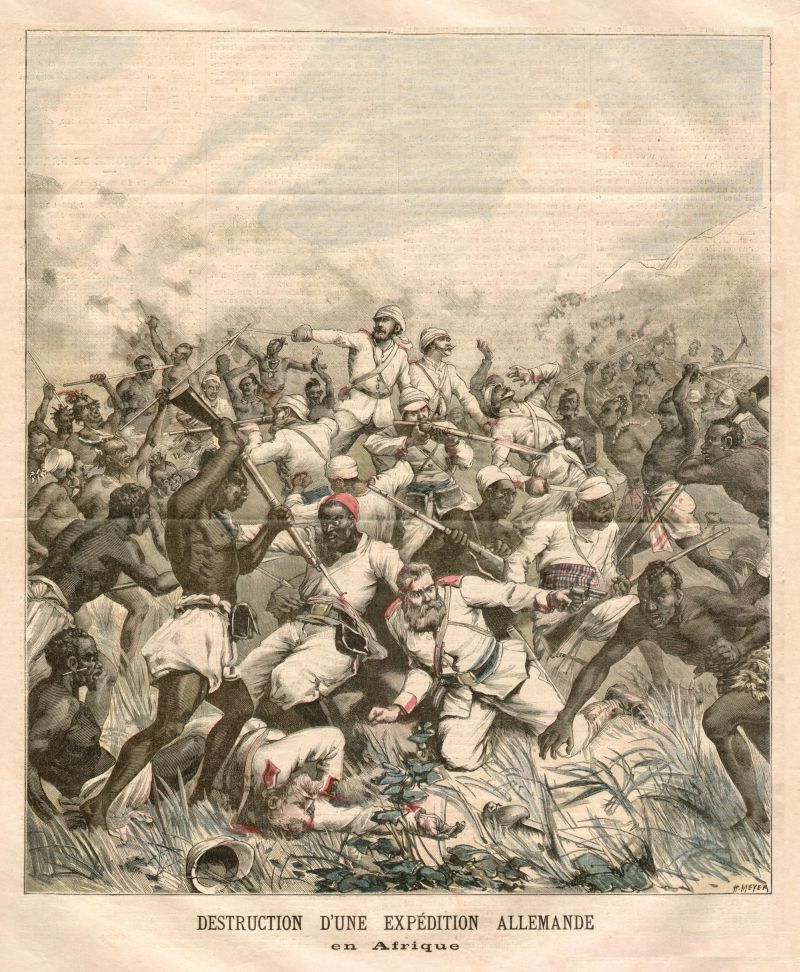
This is an article published in the French magazine "Le Petit Journal"
#45, October, 3 1891, kindly scanned by Arne
Schöfert of
Traditionsverband . I have included it on this page as
a curiosity. The Illustrator clearly had no real information as to the
appearance or uniforms of the Schutztruppe and Hehe and has simply made educated
guesses. The same goes for the journalism which is typical of the era yet sounds
to the modern reader more like blatant anti-Germany propaganda than a serious
news piece (see translation below).
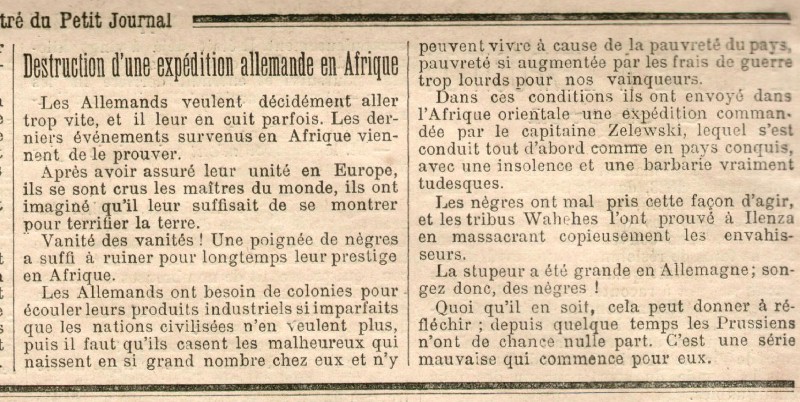
"Destruction of a German Expedition in Africa
The Germans went decidedly too fast and cooked themselves, as recent events
in Africa have shown.
After having assurance of their unity in Europe, they believe themselves to
be masters of the World. They imagine that they are sufficient to terrify
the earth.
Vanity of vanities! A group of negroes was sufficient to ruin their prestige
in Africa.
The Germans had a need for colonies to sell their industrial products which
due to their imperfections are not suitable for civilised nations. Then they
have so many new births that they cannot survive because of the poverty of
the country, augmented by the poverty caused by war.
In these conditions they sent an expedition to East Africa commanded by
Captain Zelewski, he first arrived in this conquered country with typical
Teutonic insolence and barbarity.
The Wahehe tribe saw this as the wrong way to act and have massacred large
numbers of the invaders.
The astonishment was great in Germany, as you know, the negroes!
This may give a pause for some time- the Prussians have no chance anywhere.
This is the start of a bad series of events for them." |
|
|
|
|
|
|
|
|
|
|
|
|
|
|
|
Sources and Further Reading
"Aus dem Bericht des Lieutenants v. Tettenborn über den Untergang der Expedition
v. Zelewski" (Staatsbibliothek zu Berlin)
"Geschichte der kaiserlichen
Schutztruppe fur Deutsche-Ostafrika" by Ernst Nigmann, translated into
English as-
"German Schutztruppe in East Africa 1889-1911" by
Ernst Nigmann (Published by
Battery Press)
"Warrior Peoples of East Africa 1840-1900" by Chris Peers (published by
Osprey
Men-at-Arms)
"Colonial Armies: Africa 1850 to 1918" by Peter Abbott (Published by
Foundry)
"Across Africa" by Verney Lovett Cameron (published by Ripping Yarns)
"The
Colonial Wars of Imperial Germany" by Paul Beck (on the
Savage
and Soldier website)
Mkwawa.com an
online study of Mkwawa and the Wahehe
Wikipedia page on the
Hehe based on the following books-
"Eine Kopfjagt" by Martin Baer and Olaf Schöter
"Raising the Flag of War" by Andreus Bauer
"Schutztruppe Deutsch Ostafrika" by Holger Doebold
"A Modern History of Tanganyika" by John Iliffe
"The Wahehe" by Alison Remayne
"Die Wahehe" by Ernst Nigmann
"Gegen Araber und Wahehe" by Tom von Prince
Wikipedia - Gefecht bei Lula-Rugaro
| Recommended Further Reading |
| |
|
|
|
|
|
|
|
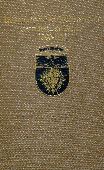
"German
Schutztruppe
in East Africa 1889-1911"
by Ernst Nigmann
translated by RE Dohrenwend
Available from Battery Press |
|
|
| |
|
|
|
|
Special Thanks on this page go to Per Finsted of
Chakoten and Arne Schöfert
of Traditionsverband
|
|
|
|
|
|
|